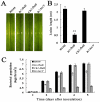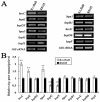Fructose-bisphophate aldolase exhibits functional roles between carbon metabolism and the hrp system in rice pathogen Xanthomonas oryzae pv. oryzicola
- PMID: 22384086
- PMCID: PMC3285194
- DOI: 10.1371/journal.pone.0031855
Fructose-bisphophate aldolase exhibits functional roles between carbon metabolism and the hrp system in rice pathogen Xanthomonas oryzae pv. oryzicola
Abstract
Fructose-bisphophate aldolase (FbaB), is an enzyme in glycolysis and gluconeogenesis in living organisms. The mutagenesis in a unique fbaB gene of Xanthomonas oryzae pv. oryzicola, the causal agent of rice bacterial leaf streak, led the pathogen not only unable to use pyruvate and malate for growth and delayed its growth when fructose was used as the sole carbon source, but also reduced extracellular polysaccharide (EPS) production and impaired bacterial virulence and growth in rice. Intriguingly, the fbaB promoter contains an imperfect PIP-box (plant-inducible promoter) (TTCGT-N(9)-TTCGT). The expression of fbaB was negatively regulated by a key hrp regulatory HrpG and HrpX cascade. Base substitution in the PIP-box altered the regulation of fbaB with the cascade. Furthermore, the expression of fbaB in X. oryzae pv. oryzicola RS105 strain was inducible in planta rather than in a nutrient-rich medium. Except other hrp-hrc-hpa genes, the expression of hrpG and hrpX was repressed and the transcripts of hrcC, hrpE and hpa3 were enhanced when fbaB was deleted. The mutation in hrcC, hrpE or hpa3 reduced the ability of the pathogen to acquire pyruvate and malate. In addition, bacterial virulence and growth in planta and EPS production in RΔfbaB mutant were completely restored to the wild-type level by the presence of fbaB in trans. This is the first report to demonstrate that carbohydrates, assimilated by X. oryzae pv. oryzicola, play critical roles in coordinating hrp gene expression through a yet unknown regulator.
Conflict of interest statement
Figures







Similar articles
-
[Expression of the hrcC, hrpE and hpa3 genes is not regulated by the hrpG and hrpX genes in a rice pathogen Xanthomonas oryzae pv. oryzicola].Wei Sheng Wu Xue Bao. 2009 Aug;49(8):1018-25. Wei Sheng Wu Xue Bao. 2009. PMID: 19835162 Chinese.
-
A novel regulatory role of HrpD6 in regulating hrp-hrc-hpa genes in Xanthomonas oryzae pv. oryzicola.Mol Plant Microbe Interact. 2011 Sep;24(9):1086-101. doi: 10.1094/MPMI-09-10-0205. Mol Plant Microbe Interact. 2011. PMID: 21615204
-
Elucidation of the hrp clusters of Xanthomonas oryzae pv. oryzicola that control the hypersensitive response in nonhost tobacco and pathogenicity in susceptible host rice.Appl Environ Microbiol. 2006 Sep;72(9):6212-24. doi: 10.1128/AEM.00511-06. Appl Environ Microbiol. 2006. PMID: 16957248 Free PMC article.
-
GamR, the LysR-Type Galactose Metabolism Regulator, Regulates hrp Gene Expression via Transcriptional Activation of Two Key hrp Regulators, HrpG and HrpX, in Xanthomonas oryzae pv. oryzae.Appl Environ Microbiol. 2016 Jun 13;82(13):3947-3958. doi: 10.1128/AEM.00513-16. Print 2016 Jul 1. Appl Environ Microbiol. 2016. PMID: 27107122 Free PMC article.
-
Identification of HrpX regulon genes in Xanthomonas oryzae pv. oryzicola using a GFP visualization technique.Arch Microbiol. 2012 Apr;194(4):281-91. doi: 10.1007/s00203-011-0758-x. Epub 2011 Oct 11. Arch Microbiol. 2012. PMID: 21987378
Cited by
-
A LysR-Type Transcriptional Regulator LcrX Is Involved in Virulence, Biofilm Formation, Swimming Motility, Siderophore Secretion, and Growth in Sugar Sources in Xanthomonas axonopodis Pv. glycines.Front Plant Sci. 2020 Jan 10;10:1657. doi: 10.3389/fpls.2019.01657. eCollection 2019. Front Plant Sci. 2020. PMID: 31998344 Free PMC article.
-
Ketoglutarate transport protein KgtP is secreted through the type III secretion system and contributes to virulence in Xanthomonas oryzae pv. oryzae.Appl Environ Microbiol. 2012 Aug;78(16):5672-81. doi: 10.1128/AEM.07997-11. Epub 2012 Jun 8. Appl Environ Microbiol. 2012. PMID: 22685129 Free PMC article.
-
Xanthomonas oryzae Pv. oryzicola Response Regulator VemR Is Co-opted by the Sensor Kinase CheA for Phosphorylation of Multiple Pathogenicity-Related Targets.Front Microbiol. 2022 Jun 9;13:928551. doi: 10.3389/fmicb.2022.928551. eCollection 2022. Front Microbiol. 2022. PMID: 35756024 Free PMC article.
-
Dissection of brassinosteroid-regulated proteins in rice embryos during germination by quantitative proteomics.Sci Rep. 2016 Oct 5;6:34583. doi: 10.1038/srep34583. Sci Rep. 2016. PMID: 27703189 Free PMC article.
-
Transcriptome of Pectobacterium carotovorum subsp. carotovorum PccS1 infected in calla plants in vivo highlights a spatiotemporal expression pattern of genes related to virulence, adaptation, and host response.Mol Plant Pathol. 2020 Jun;21(6):871-891. doi: 10.1111/mpp.12936. Epub 2020 Apr 8. Mol Plant Pathol. 2020. PMID: 32267092 Free PMC article.
References
-
- Eisenreich W, Dandekar T, Heesemann J, Goebel W. Carbon metabolism of intracellular bacterial pathogens and possible links to virulence. Nat Rev Microbiol. 2010;8:401–412. - PubMed
-
- Wang LF, Rong W, He CZ. Two Xanthomonas extracellular polygalacturonases, PghAxc and PghBxc, are regulated by type III secretion regulators HrpX and HrpG and are required for virulence. Mol Plant-Microbe Interact. 2008;21:555–563. - PubMed
Publication types
MeSH terms
Substances
LinkOut - more resources
Full Text Sources

